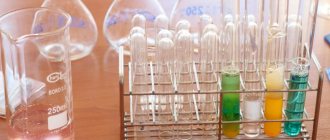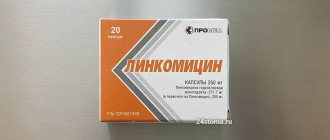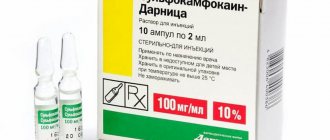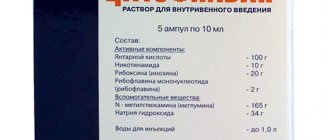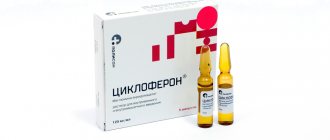Galantamine
Galantamine is administered intravenously, intramuscularly, subcutaneously, transdermally (by iontophoresis), orally in tablets.
The dose is selected individually, taking into account the patient’s age, the nature of the disease, the effectiveness and tolerability of the drug. At the beginning of treatment, the minimum effective dose is prescribed, gradually increasing it. Orally, the maximum daily dose for adults is 10-40 mg in 2-4 divided doses. For myasthenia gravis
The daily dose is divided into 3 doses. When treating dementia of the Alzheimer's type, the recommended initial dose is 8 mg per day - 4 mg 2 times a day, after 4 weeks they switch to a maintenance dose - 16 mg (8 mg 2 times a day), which is taken for at least 4 weeks. The question of increasing the maintenance dose to the maximum (24 mg per day) must be decided after assessing the clinical situation (the achieved effect and tolerability). When switching from a drug in the form of tablets, taken 2 times a day, to a dosage form in the form of extended-release capsules, taken 1 time per day, the total daily dose should remain unchanged.
Subcutaneously, adults: 2.5-10 mg 1-2 times a day, maximum single and daily doses of 10 mg and 20 mg, respectively. Subcutaneously, children: 1-2 times a day, at the age of 1-2 years - 0.25-1.0 mg per day, 3-5 years - 0.5-5.0 mg per day, 6-8 years - 0.75-7.5 mg per day, 9-11 years - 1.0-10.0 mg per day, 12-15 years - 1.25-12.5 mg per day, 15-16 years - 12 .5-20.0 mg per day. The larger dose is divided into 2 injections per day.
The duration of treatment depends on the nature and severity of the disease, most often - 40-60 days, the course of treatment can be carried out 2-3 times with intermediate periods of 1-2 months.
Intravenously, as an antagonist of antidepolarizing muscle relaxants: adults - 10-20 mg per day, children from 1 year - 1-2 mg, 3-5 years - 1.5-3 mg, 6-8 years - 2-5 mg, 9-11 years old - 3-8 mg, 12-15 years old - 5-10 mg.
Intramuscularly, for X-ray studies, it is used in adults at a dose of 1-5 mg. For diseases of the peripheral nervous system and for the treatment of bedwetting, it is used in children in the form of iontophoresis in a dose of 1-2 ml of a 0.25% solution.
Use in elderly patients
Use in the elderly has not been systematically studied. Due to the large number of contraindications that are most applicable to older people (for example, chronic heart failure or long-term use of beta blockers), careful examination and subsequent active monitoring of the condition of such patients is necessary.
Use in children
Application is possible according to the dosage regimen. Contraindicated in children under 1 year of age (for solution), under 9 years of age (for tablets).
Galantamine Canon (capsules) 8mg, 16mg, 24mg
Pharmacodynamics
Galantamine (tertiary alkaloid) is a selective, competitive and reversible inhibitor of acetylcholinesterase. In addition, galantamine enhances the effect of acetylcholine on nicotinic receptors, probably due to binding to the allosteric site of the receptor. By increasing the activity of the cholinergic system, cognitive function may improve in patients with dementia of the Alzheimer's type.
Pharmacokinetics
Galantamine is a basic compound with a single dissociation constant (pKa 8.2). It has weak lipophilicity with a distribution coefficient (LogP) between n-octanol and a buffer solution (pH 12) of 1.09. Solubility in water (pH 6) is 31 mg/ml. Galantamine has 3 chiral centers. S, R, S-configuration is natural (natural). Galantamine is partially metabolized by various cytochromes, mainly the isoenzymes CYP2D6 and CYP3A4. Some of the metabolites formed during the degradation of galantamine are active in vitro, but are not significant in vivo.
Suction
The absolute bioavailability of galantamine when taken orally is high - 88.5 ± 5.4%. The area under the concentration-time curve (AUC24h) and the minimum concentration (Cmin) in plasma are similar to those when taking immediate-release galantamine twice a day. The maximum concentration (Cmax) in the blood plasma is reached after 4.4 hours. The Cmax of extended-release galantamine is 24% lower than after taking immediate-release galantamine. Food intake does not have a significant effect on AUC, but causes an increase in Cmax by approximately 12% and an extension of the time to reach Cmax (TCmax) by approximately 30 minutes. However, these changes are not clinically significant.
Distribution
The average volume of distribution (Vd) is 175 l. The degree of binding to plasma proteins is low and amounts to (18%).
Metabolism
In vitro studies have shown that the main isoenzymes of the cytochrome P450 system involved in the biotransformation of galantamine are CYP2D6 and CYP3A4. The CYP2D6 isoenzyme is involved in the formation of O-desmethylgalantamine, and the CYP3A4 isoenzyme is involved in the formation of N-oxide-galantamine. Excretion of the radioactive dose by the kidneys and through the intestines does not differ in patients with “slow” and “fast” metabolism (low and high activity of the CYP2D6 isoenzyme, respectively). In the blood plasma of patients with “fast” and “slow” metabolism, the main part of the radioactive substances consists of unchanged galantamine and its glucuronide. After a single dose of galantamine, none of the active metabolites of galantamine (norgalantamine, O-desmethylgalantamine and O-desmethylnorgalantamine) were detected in unconjugated form in the blood plasma of patients with “fast” and “slow” metabolizers. Norgalantamine was detected in the blood plasma of patients after long-term use of the drug, and its concentration was no more than 10% of the concentration of galantamine. In vitro studies indicate a very low ability of the main isoenzymes of the human cytochrome P450 system to inhibit galantamine.
Removal
The elimination of galantamine is biexponential. The terminal half-life (T/1/2) in healthy volunteers is 8-10 hours. Based on the results of studies of immediate-release galantamine in population studies, the clearance of oral galantamine in the target population is typically about 200 ml/min, with interindividual variability 30 %. 7 days after a single oral dose of 4 mg of 3H-galantamine, 90-97% of the radioactive dose is excreted by the kidneys in the form of unchanged galantamine and 2.2-6.3% through the intestines. After intravenous and oral administration, 18-22% of the dose was excreted as unchanged galantamine through the kidneys within 24 hours. Renal clearance was 65 ml/min (20-25% of total plasma clearance). Pharmacokinetics are linear in the dose range from 8 mg to 24 mg when administered once daily in elderly and young patients.
Pharmacokinetics of special groups of patients
The results of clinical studies have shown that in patients with Alzheimer's disease, the concentration of galantamine in the blood plasma is 30-40% higher than in young healthy individuals. Based on an analysis of population pharmacokinetic data, clearance in women is 20% lower compared to men. The clearance of galantamine in patients with “slow” metabolizers of the CYP2D6 isoenzyme is 25% lower compared to patients with “fast” metabolizers, while bimodality is not observed in the population. Thus, the patient's metabolic status is not considered clinically significant in the general population. Hepatic impairment: In patients with mild hepatic impairment (Child-Pugh score 5-6), the pharmacokinetic parameters of galantamine were similar to those in healthy subjects. In patients with moderate hepatic impairment (Child-Pugh score 7-9), the AUC and T1/2 of galantamine were increased by approximately 30%. Impaired renal function: In patients with Alzheimer's disease and impaired renal function (creatinine clearance (CC) ≥ 9 ml/min), no dose adjustment is required.
Pharmacokinetic-pharmacodynamic relationship
In large phase III studies with galantamine 12 mg and 16 mg twice daily dosing regimens, there was no apparent correlation between mean plasma concentrations and efficacy measures (changes in Alzheimer's Disease Assessment of Cognitive Scale (ADAS-cog/11) and assessment of the patient's condition based on the impressions of the doctor and caregivers (CIBIC-plus) at the 6th month of therapy). Plasma concentrations in patients with syncope were in the same range as in other patients taking the same dose. The occurrence of nausea correlates with a higher peak plasma concentration.
Galantamine Canon (tablets) 4mg, 8mg, 12mg
The drug Galantamine Canon is indicated for the treatment of mild to moderate dementia of the Alzheimer's type. The effectiveness of galantamine in patients with other types of dementia and other memory disorders has not been established. Also, no positive effect of galantamine use (for 2 years) on slowing down cognitive impairment and slowing down the transition to clinically significant dementia in patients with the syndrome of “mild” cognitive decline (“mild” types of memory impairment that do not meet the criteria for Alzheimer’s type dementia) has been established ). Mortality was significantly higher in the galantamine group than in the placebo group, 14/1026 (1.4%) of patients receiving galantamine and 3/1022 (0.3%) of patients receiving placebo. The causes of death varied. About half of the deaths in the galantamine group were due to various vascular causes (myocardial infarction, stroke and sudden death). The significance of these findings for the treatment of patients with dementia of the Alzheimer's type is unknown. Placebo-controlled studies in patients with dementia of the Alzheimer's type were conducted for 6 months only. In these studies, mortality was not increased in the galantamine group.
Treatment with Galantamine Canon should only be carried out under the supervision of a physician and under the supervision of a person caring for the patient.
Patients with Alzheimer's disease lose weight. Treatment with cholinomimetic drugs, including galantamine, is accompanied by a decrease in body weight, so this indicator should be monitored during therapy.
Like other cholinomimetic drugs, Galantamine Canon should be used with caution in the following diseases:
Diseases of the cardiovascular system
Due to their pharmacological action, cholinomimetic drugs can cause vagotonic effects (for example, bradycardia). It should be used with caution in patients with SSS and other disorders of supraventricular conduction, during simultaneous therapy with drugs that reduce heart rate (digoxin and beta-blockers) and in patients with electrolyte metabolism disorders (hyperkalemia, hypokalemia); in the period after acute myocardial infarction; with newly diagnosed atrial fibrillation; in patients with atrioventricular block II-III degree, unstable angina or chronic heart failure, especially functional class III-IV according to the NYHA classification.
During therapy with Galantamine Canon for dementia of the Alzheimer's type, the risk of developing adverse reactions from the cardiovascular system increases.
Digestive system diseases
In patients with an increased risk of developing erosive and ulcerative lesions of the gastrointestinal tract (for example, a history of gastric and duodenal ulcers, NSAID therapy), it is necessary to monitor the condition in order to early identify the corresponding pathological symptoms. Galantamine Canon is not recommended for use in patients with gastrointestinal obstruction or after recent gastrointestinal surgery.
Nervous system diseases
The use of cholinomimetic drugs may cause convulsions. It should be remembered that seizure activity can be a manifestation of Alzheimer's disease itself. In rare cases, increased cholinergic tone may worsen Parkinson's disease.
Cerebrovascular events have been reported infrequently in patients with dementia of the Alzheimer's type using galantamine. This should be taken into account when prescribing galantamine to patients with cerebrovascular pathology.
Respiratory system diseases
The drug Galantamine Canon should be prescribed with caution to patients with severe asthma, COPD, acute infectious diseases of the lungs (for example, pneumonia).
Kidney and urinary tract diseases
Galantamine Canon is not recommended for use in patients with urinary tract obstruction who have recently undergone bladder surgery.
General anesthesia
Galantamine, which is a cholinomimetic, can enhance the blockade of depolarizing-type neuromuscular transmission (muscle relaxation) caused by general anesthesia (when used as a peripheral muscle relaxant, suxamethonium), especially in cases of pseudocholinesterase deficiency.
If treatment is suddenly stopped (for example, before surgery), withdrawal syndrome does not develop.
The influence of a medicinal product for medical use on the ability to drive vehicles and machinery
The drug Galantamine Canon, like other cholinomimetic drugs, can cause drowsiness and dizziness, which negatively affect the control of transport and other mechanisms, especially in the first weeks after the start of treatment.
GALANTAMINE
Pharmacokinetics
Galantamine is a basic compound with a single dissociation constant (pKa 8.2). It has weak lipophilicity with a partition coefficient (LogP) between n-octanol and a buffer solution (pH 12) of 1.09. Solubility in water (pH 6) is 31 mg/ml. Galantamine has 3 chiral centers. S, R, S-configuration is natural (natural). Galantamine is partially metabolized by various cytochromes, mainly by the isoenzymes CYP2D6 and CYP3A4. Some of the metabolites formed during the degradation of galantamine are active in vitro
, but do not play a significant role in
in vivo conditions.
General characteristics of galantamine
Suction
The absorption rate is high, the time to reach maximum concentration (TCmax) is about 1 hour. The absolute bioavailability of galantamine is high - 88.5 ± 5.4%. Eating reduces the rate of absorption and reduces the maximum concentration (Cmax) by approximately 25%, without affecting the extent of absorption (AUC).
Distribution
The average volume of distribution (Vd) is 175 l. Plasma protein binding is low at 18%.
Metabolism
In vitro studies
showed that the main isoenzymes of the cytochrome P450 system involved in the biotransformation of galantamine are CYP2D6 and CYP3A4.
The CYP2D6 isoenzyme is involved in the formation of O-desmethylgalantamine, and the CYP3A4 isoenzyme is involved in the formation of N-oxide-galantamine. Excretion of the radioactive dose by the kidneys and through the intestines does not differ in patients with “slow” and “fast” metabolism (low and high activity of the CYP2D6 isoenzyme, respectively). In the plasma of patients with “fast” and “slow” metabolism, the main part of the radioactive substances consists of unchanged galantamine and its glucuronide. After a single dose of galantamine, none of the active metabolites of galantamine (norgalantamine, O-desmethylgalantamine and O-desmethylnorgalantamine) were detected in unconjugated form in the plasma of patients with “fast” and “slow” metabolizers. Norgalantamine was detected in the plasma of patients after long-term use of the drug, and its concentration was no more than 10% of the concentration of galantamine. In vitro
studies indicate a very low ability of the main isoenzymes of the human cytochrome P450 system to inhibit galantamine.
Removal
The elimination of galantamine is biexponential. The terminal half-life (T1/2) in healthy volunteers is 7-8 hours. Based on studies of immediate-release galantamine in population studies, oral clearance of galantamine in the target population is typically approximately 200 ml/min with an interindividual variability of 30%. 7 days after a single oral dose of 4 mg of 3H-galantamine, 90-97% of the radioactive dose is excreted by the kidneys in the form of unchanged galantamine and 2.2-6.3% by the intestines. After intravenous and oral administration, 18-22% of the dose was excreted as unchanged galantamine by the kidneys within 24 hours. Renal clearance was 68.4 ± 22 ml/min (20-25% of total plasma clearance).
Linearity of pharmacokinetics
Pharmacokinetics are linear in the range of 4-16 mg when taken 2 times a day. In patients taking galantamine at a dose of 12 or 16 mg 2 times a day, no accumulation was observed in the interval from 2 to 6 months.
Pharmacokinetics of special groups of patients
The results of clinical studies have shown that in patients with Alzheimer's disease the plasma concentration of galantamine is 30-40% higher than in young healthy individuals. Based on an analysis of population pharmacokinetic data, clearance in women is 20% lower compared to men. The clearance of galantamine in patients with low activity of the CYP2D6 isoenzyme is 25% lower compared to patients with “fast” metabolism, while bimodality is not observed in the population. Thus, the patient's metabolic status is not considered clinically significant in the general population.
Liver dysfunction:
in patients with mild hepatic impairment (Child-Pugh score 5-6), the pharmacokinetic parameters of galantamine were similar to those in healthy people. In patients with moderate liver dysfunction (7-9 points on the Child-Pugh scale), the area under the pharmacokinetic curve “dosage and administration method”).
Renal dysfunction
: Elimination of galantamine is reduced along with a decrease in creatinine clearance (CC) (results of a study in subjects with impaired renal function). Compared with patients with Alzheimer's disease, maximum and minimum plasma concentrations were not increased in patients with CC ≥ 9 ml/min. Therefore, an increase in the frequency of adverse events is not expected, and no dose adjustment is required.
Pharmacokinetic-pharmacodynamic relationship
In large phase III studies with dosing regimens of galantamine 12 mg and 16 mg twice daily, there was no apparent correlation between mean plasma concentrations and efficacy measures (changes in ADAS-cog11 and CIBIC-plus scales at 6 months of therapy).
Plasma concentrations in patients with syncope were in the same range as in other patients taking the same dose.
The occurrence of nausea correlates with increased maximum plasma concentrations.
